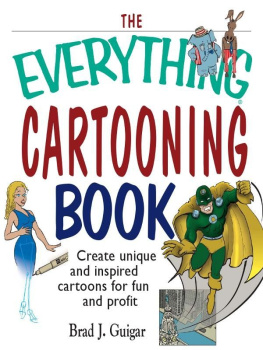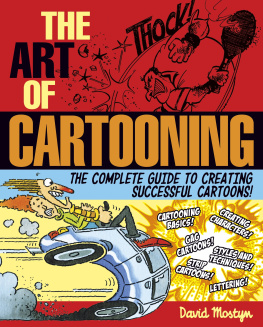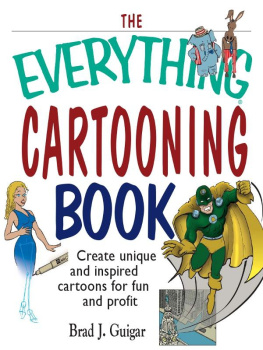Contents
Acknowledgments
Id like to thank a few people whose expertise in their fields made them invaluable assets in assembling information for this book. Meaghan Quinn, a Webcartoonist ( www.eattheroses.com ), helped explain the world of manga. Rich Bailey, of the Philadelphia Daily News color lab, clarified page pairing and other prepress issues. My process for scanning line art is based on advice given to me by Harry Stone, also of the Daily News color lab. Finally, thanks to Stu Rees for sharing information on copyright and trademark law.
www.eattheroses.com ), helped explain the world of manga. Rich Bailey, of the Philadelphia Daily News color lab, clarified page pairing and other prepress issues. My process for scanning line art is based on advice given to me by Harry Stone, also of the Daily News color lab. Finally, thanks to Stu Rees for sharing information on copyright and trademark law.
Most importantly, thanks to my wife, Caroline, and my son, Alex, without whose unwavering support this book would have been impossible. Thanks, as well, to my parents, John and Rita Guigar, and my in-laws, Tim and Joyce Miller, for their love, understanding, and support.
Top Ten Newspaper Cartoonists
1. Charles Schulz, Peanuts. In a bittersweet story befitting his comic, Schulz announces a retirement forced upon him by the ravages of colon cancer, then dies quietly in his sleep the night before his final Sunday comic strip appears in newspapers.
2. Gary Larson, The Far Side. A decade after he ended his daily feature, new single panel comics are still accused of being Far Side ripoffs.
3. Thomas Nast, political cartoonist. Corrupt politician William Marcy Boss Tweeda constant target of Nasts political cartoonsoffered the artist more than $100,000 to study art abroad. The offer rose to half a million and then turned into a death threat. Later, Spanish authorities used a Nast cartoon to identify and apprehend the fleeing Tweed.
4. Will Eisner, The Spirit. Although Eisner is widely known as a pioneer in the comic-book industry, he got his start when The Spirit started appearing in newspaper comic-book supplements.
5. Walt Kelly, Pogo. Devastating political satirist and a master of language rivaling Dr. Seuss, Kelly paved the way for future satirists like Aaron McGruder and Garry Trudeau (see #6).
6. Garry Trudeau, Doonesbury. Besides being one of the foremost examples of political satire, his comic strip is one of the few that achieved longevity without becoming stale.
7. Bill Watterson, Calvin and Hobbes. One of the rare cartoonists who boasted consistently funny writing with breathtaking illustration, Watterson made us remember our childhood the way no one had done before.
8. Berkeley Breathed, Bloom County. Mixing thoughtful political and social satire with heavy doses of plain old lunacy, Breathed defined the 1980s for many comics fans.
9. Bud Fisher, Mutt and Jeff. The first successful daily newspaper comic strip, appearing in the San Francisco Examiner for the first time in 1907.
10. Scott Adams, Dilbert, and Jim Davis, Garfield (tie). Both cartoonists have proven to be both excellent humorists as well as savvy businessmen, parlaying their creations into formidable wealth.
Introduction
 TO BE A CARTOONIST is to master one of the last true forms of magic here on earth. The ability of a cartoon to tug at a heartstring or tickle a rib is truly amazing. From wartime propaganda to modern-day Japanese manga, cartoon art has proven to have extraordinary communication properties. It can convey an idea that would otherwise take paragraphs to explain. It can make us feel. Thats magic.
TO BE A CARTOONIST is to master one of the last true forms of magic here on earth. The ability of a cartoon to tug at a heartstring or tickle a rib is truly amazing. From wartime propaganda to modern-day Japanese manga, cartoon art has proven to have extraordinary communication properties. It can convey an idea that would otherwise take paragraphs to explain. It can make us feel. Thats magic.
Cartoon art separates itself from other art forms in two main ways. First, cartoon art exploits the human eyes ability to discern familiar objects from abstract shapes. Second, time is depicted by the sequential progression of images.
Cartoons take advantage of the eyes eagerness to find logic in shapes. Objects can be simplified into their most general shapes. A face can be represented with a circle, two dots, and a line for the mouth. Not all cartoons feature this kind of oversimplification, but all take advantage of the intrinsic need for humans to organize shapes into familiar mental images.
This can be a powerful tool, when used wisely. For example, a rectangle with a triangle on top (and a little embellishing) reads as a house. Any house, in any city. It can read as your house. Since there arent any identifying characteristics to classify it otherwise, your eyes will fill in the necessary detailsor the details it is cued to fill in.
Show the cartoon to a farmer in Bad Axe, Michigan, and hell correctly identify it as a houseas he envisions an aluminum-sided ranch-style house. Show the same drawing to a Philadelphia urbanite and she will make the same identificationas she pictures a brick-built row house. One image, many interpretations. Pretty powerful stuff for communicating complex ideas to large groups of people.
If you think about it, this also makes cartoon art one of the first truly interactive art forms! Every person who views a cartoon translates the images based on his or her background. Its this interactive play between reader and image that gives cartoon art such punch. The reader identifies strongly with the image becauseknowingly or notshe has invested something of herself into the image.
The other defining concept in cartooning plays off the willingness of the mind to read sequential images as a continuous narrative. In other words, as images are gathered into a unit, the brain puts them into an ordermuch like it did when presented with the primitive house. Faced with sequential images, the brain assumes a first this happened, then that happened correlation between the images. Instead of being seen as a grouping of separate ideas, sequential images are seen to have a chronological relationship with one another. Without that relationship, there are only static, unrelated images. The presence of that relationship makes storytelling possible. Time passes; plots unfold; and characters act, react, and change. Furthermore, time can be shown to pass in small increments or in large leaps. Time can go forward or backward. Several actions can be depicted as happening at the same time. Or time can be made to stand still.
So, whereas the interactive play between viewer and image gives a cartoon power, it is this depiction of time through sequential images that gives a cartoon its magic. And as this happens, those images become more than concepts; they become real. Interactive imagery makes us recognize a cartoon. Sequential storytelling makes us care. Pure magic.
The
EVERYTHING
Cartooning Book
Dear Reader:
Cartooning gives me incredible satisfaction. Ive been publishing a daily comic strip on the Web since 2000. You can read todays comic at  www.greystoneinn.net. It appears in newspapers, toothe largest of which is the Philadelphia Daily News. I have three comic strip collections published in book form. Even my day job was the result of advice from an editorial cartoonist who suggested Id have better luck submitting cartoons to a newspaper as an employee. That led to a career in journalism, which has lasted more than a decade.
www.greystoneinn.net. It appears in newspapers, toothe largest of which is the Philadelphia Daily News. I have three comic strip collections published in book form. Even my day job was the result of advice from an editorial cartoonist who suggested Id have better luck submitting cartoons to a newspaper as an employee. That led to a career in journalism, which has lasted more than a decade.
Ive had this obsession with cartooning since I was about eight years old. Ive been drawing as far back as I can remember. I doodled more than I took notes in college. I own more graphic novels and comic strip collections than any other type of book.
Thats why I wanted to write this book. Its the only subject I really feel qualified to teach. If youre a beginner, I can help you get started. If youve been cartooning for a while, I can help you take the next step to professional work. And if youre an experienced cartoonist, I have some tips and tricks that will help you become even better at what you do.
Next page






 www.eattheroses.com ), helped explain the world of manga. Rich Bailey, of the Philadelphia Daily News color lab, clarified page pairing and other prepress issues. My process for scanning line art is based on advice given to me by Harry Stone, also of the Daily News color lab. Finally, thanks to Stu Rees for sharing information on copyright and trademark law.
www.eattheroses.com ), helped explain the world of manga. Rich Bailey, of the Philadelphia Daily News color lab, clarified page pairing and other prepress issues. My process for scanning line art is based on advice given to me by Harry Stone, also of the Daily News color lab. Finally, thanks to Stu Rees for sharing information on copyright and trademark law. TO BE A CARTOONIST is to master one of the last true forms of magic here on earth. The ability of a cartoon to tug at a heartstring or tickle a rib is truly amazing. From wartime propaganda to modern-day Japanese manga, cartoon art has proven to have extraordinary communication properties. It can convey an idea that would otherwise take paragraphs to explain. It can make us feel. Thats magic.
TO BE A CARTOONIST is to master one of the last true forms of magic here on earth. The ability of a cartoon to tug at a heartstring or tickle a rib is truly amazing. From wartime propaganda to modern-day Japanese manga, cartoon art has proven to have extraordinary communication properties. It can convey an idea that would otherwise take paragraphs to explain. It can make us feel. Thats magic.